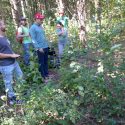Bird habitat changing quickly as climate change proceeds
The climatic conditions needed by 285 species of land birds in the United States have moved rapidly between 1950 and 2011 as a result of climate change, according to a recent paper published in Global Change Biology.
“Our goal was to look at the climate where these birds were observed breeding over this period and determine where that ‘sweet spot’ was moving as the climate changed in this period,” says first author Brooke Bateman, a post-doctoral researcher at the University of Wisconsin–Madison.
Warming temperatures are the fundamental alteration of climate change, and the researchers saw the expected northward expansion of suitable conditions, Bateman says, but also a considerable expansion to the west. Unexpectedly, the southern borders of suitable conditions did not, in general, move north, perhaps because a remnant population had not yet left that area.
In general, the southern plains and lower Midwest faced the greatest decline in ideal climate conditions, while the Dakotas, mid-Atlantic and Pacific Coast showed the greatest increase.
The study, the largest examination of the velocity of climate change for birds in the United States in the recent past, began by combining detailed weather records for the lower 48 states with data on the location of bird occurrences from the Global Biodiversity Information Facility. The researchers cross-referenced those data, creating a computer model of where the birds nest, in terms of climate factors like average and extreme temperature and precipitation.
In the face of climate change, a suitable climate for birds has been moving, on average, eight tenths of a mile per year—about twice the pace predicted by earlier studies.
The researchers then used the model to predict where the same climate conditions for those birds would be located in 2011, reflecting the ensuing changes in climate. Finally, using data from the 2011 North American Breeding Bird Survey, they checked their work.
The results show that in the face of climate change, a suitable climate for birds has been moving, on average, eight tenths of a mile per year—about twice the pace predicted by earlier studies.
To make sense of their data, the researchers lumped bird species into guilds—groups based on shared factors like diet, foraging location and migration habits. Hospitable climate moved relatively fast for short- or long-distance migrants, carnivores, insect eaters, and birds that foraged in the air or the canopy of trees. Slow-moving guilds included permanent residents, herbivores, omnivores, hummingbirds and birds that forage on tree bark, such as woodpeckers.
The findings are a significant expansion on the notion that climate change, once called “global warming,” would simply force species to the north, or to higher altitudes. In fact, climate change affects wildlife in myriad ways, says Bateman. “People used to think, with global warming, that species would move poleward to beat the heat, but the changes in rainfall and extreme weather events are equally influential, especially in driest part of year. That affects where the birds can live.”
Climate could affect predators, prey, disease or many other factors, Bateman says, but the study did not address the mechanisms behind the shifts in location. And while suitable climate is clearly moving, what is not clear is whether the plants and other animals (such as insects) that birds depend on are moving in the same way.
Bateman acknowledges that because of their mobility, birds are not fully representative of plants and ground-based animals, but they are easier to study due to the wealth of data amassed over decades of amateur observation.
The results emphasize the need for connected habitat that allows plants and animals to move as climate change continues, Bateman says. “The ideal situation would be to secure large amounts land that allows connectivity between current protected areas and areas that will become suitable,” says Bateman. “We need to think together, to make the landscape more hospitable to all of the wildlife that depends on it.”
Bateman’s co-authors included Patricia Heglund, of the U.S. Fish and Wildlife Service, and Anna Pidgeon and Volker Radeloff of the UW–Madison Department of Forest and Wildlife Ecology.
“Movement of suitable climate is not necessarily a bad thing,” Bateman says, “because the climate in some nearby areas may become more suitable for these species. However, we must consider the widespread agriculture and development in some of those new areas, in combination with the rapid pace of climate change. So even though the climate may become more suitable in those areas, the landscape is already so altered that much of this habitat is useless to the birds.”



